Simple Irrigation Audit for Home Lawns in Oklahoma
Introduction
Water is essential for life and is a requirement for plant growth. Water is a non-renewable, limited natural resource and, proper management is critical for sustainability of Oklahoma water resources. Water comprises as much as 90 percent of the fresh weight of grass plants; thus, irrigation is needed for proper culture and care of turfgrasses. Water is important for numerous metabolic functions in turfgrass plants such as photosynthesis, nutrient transport and transpiration. Photosynthesis is the process whereby plants use energy from sunlight to convert carbon dioxide and water to carbohydrates and oxygen (to the atmosphere). Transpiration is the process whereby plants transport water from roots through the plant to the leaves and ultimately to the atmosphere. Transpiration serves as a plant cooling process and also transports nutrients and solutes throughout the plant. Plant transpiration rates are dependent upon plant species and many environmental factors including temperature, relative humidity, wind/air movement and soil moisture availability. Water also can be lost before the plant is able to utilize it through atmospheric evaporation. The combination of evaporation and plant transpiration is termed evapotranspiration (ET) and is an important consideration for turfgrass irrigation.
Evapotranspiration (ET)
Evapotranspiration is an important and somewhat confusing topic for homeowners who wish to irrigate their lawn. Potential ET (ETp) refers to the maximum rate of water loss via evaporation from a given land surface under specific atmospheric conditions and takes into account factors such as air temperature, wind speed, relative humidity and solar radiation. Reference ET (ETr) takes into account the factors of ETp plus the water use of a hypothetical crop including physical plant factors such as stomata and canopy resistance. Reference ET is most often calculated through the Penman-Monteith method. Different plants may have differing water use rates, thus crop coefficients are needed to adjust ETr for the water requirements of a specific crop or plant. For the purposes of this fact sheet, we will use “ETturf” to refer to the amount of water needed for turfgrass growth. The ETturf is the amount of water needed by the turfgrass plant and takes into account ETr and turf crop coefficients for specific species. During the Oklahoma growing season, the daily ETturf rate for cool-season grasses, such as tall fescue, will generally be higher than the daily ETturf rate of warm-season grasses such as bermudagrass or zoysiagrass.
Soil Texture
In addition to ETturf, soil type is an important consideration for lawn irrigation. The amount of plant available water in the soil is highly affected by soil texture. Soil texture is categorized based on the proportion of sand, silt and clay particles. Sand particles are larger than silt particles, which are larger than clay particles. Larger particle sizes, such as sands, allow for larger pore spaces between soil particles, thus facilitating water and air flow into the soil. Small particle sizes, such as clays, have smaller pore spaces between particles thus having less space for water and air flow into the soil. Therefore, sandy soils may need to be watered more often due to low water-holding capacity, and clay soils may need to be watered less often due to high water-holding capacity. Water infiltration also is affected by soil texture. Sandy soils have rapid water infiltration rates, while clay soils have slow water infiltration rates. Soil texture can be analyzed by sending a soil sample to the Oklahoma State University (OSU) Soil, Water and Forage Analytical Laboratory. For more information on soil testing in Oklahoma, see Oklahoma Cooperative Extension Service Fact Sheets PSS-2207 and PSS-2225.
Inches of Water
We most often describe precipitation or irrigation rates in terms of inches per hour. Similarly, total rainfall or irrigation is described in terms of total inches of water. One acre of land is equal to an area of 43,560 square feet. If you take that acre of land and go one inch deep, you get one acre-inch of land. When we refer to one “inch of water,” we are referring to the quantity of water required to cover an acre-inch of land. One acre-inch of water is 27,154.3 gallons of water. Home lawns are typically measured in square feet rather than acres. As mentioned above, one acre of land is equal to an area of 43,560 square feet and one inch of water is 27,154.3 gallons of water. A typical home lawn of 5,000 square feet is equal to 0.115 acres of land (5,000 square feet / 43,560 square feet per acre). If we take 0.115 acres multiplied by 27,154.3 gallons of water (gallons of water per acre-inch), we get 3,123 gallons of water. This means that if we want to apply one inch of water to a typical 5,000 square foot yard, we need to apply 3,123 gallons of water. The phrase “inch of water” is much easier to discuss compared to 3,123 gallons of water per 5,000 square feet. The purpose of this fact sheet is to assist homeowners in determining the output of their lawn irrigation system in inches per hour.
How Many Inches of Water Does My Lawn Need?
The majority of lawns in Oklahoma are composed of warm-season grasses. Bermudagrass is the most widely used warm-season lawn grass in Oklahoma. Zoysiagrass is a warm-season grass and is used to a lesser extent in Oklahoma. Buffalograss also is a warm-season grass but is not widely used across Oklahoma. However, buffalograss is native to North America and Oklahoma but is typically only used in low or reduced maintenance yards. The most widely used cool-season grass in Oklahoma is tall fescue, which is often mixed with other cool-season species such as Kentucky bluegrass. For more information on selecting a lawn grass for Oklahoma, see Fact Sheet HLA-6418.
In general, warm-season grasses have lower ETturf compared to cool-season grasses during the growing season in Oklahoma. A general rule is that warm-season grasses, such as bermudagrass, require about one inch of water per week, while cool-season grasses, such as tall fescue, may require up to two inches of water per week, especially during the summer months (Tables 1 and 2). There are many times during the growing season where natural rainfall will be adequate to meet these requirements. However, during dry periods, especially in July and August, supplemental irrigation will be required to maintain turfgrass quality.
A more accurate estimate of turfgrass water need can be obtained through the calculation of ETturf specifically for your city or region. The OSU Cooperative Extension Service affiliated website called Simple Irrigation Plan (SIP) can help you to determine the daily or weekly ETturf for your area by automatically calculating ETturf for you based on information provided by the Oklahoma Mesonet system. For more information, visit: http://sip.mesonet.org.
How Many Inches of Water Does My Irrigation System Apply and How Uniform is the Distribution of Water?
A simple irrigation audit can be used to measure the general output and uniformity of your lawn irrigation system. While a certified irrigation audit takes into account several complicated factors and mathematical calculations, a simple irrigation audit can be performed by any homeowner with a basic knowledge of mathematics. Although this method is not as precise or accurate as a professional irrigation audit, the simple irrigation audit can give every homeowner a good estimate of their irrigation output and uniformity. Through the simple irrigation audit, you will be able to obtain an estimate of irrigation output in terms of inches per hour.
Another important factor concerning lawn irrigation is the distribution of uniformity (DU). Distribution of uniformity can be calculated via the Christiansen uniformity coefficient, which essentially takes the average irrigation output of the lowest quarter of values and divides it by the average of the irrigation output over the total area. The basic concept of DU is that we want to apply water as evenly as possible across the entire yard. A DU of 100 percent means that the irrigation system is distributing water evenly over 100 percent of the irrigated area, but 100 percent DU is not attainable through an irrigation system. A good DU for a home lawn is between 70 percent to 80 percent. For example, assume a single home irrigation system applies one-half inch per hour of irrigation to some areas of the lawn and one-fourth inch per hour to other areas. As you can see, to apply one-half inch to the whole lawn, you would have to irrigate for two hours. Under this scenario, some areas of the lawn would be overwatered and receive 1.0 inch of water while others would receive the target application of 0.5 inch of water. Thus, the closer the DU is to 100 percent, the better.
Table 1. Average monthly bermudagrass evapotranspiration (ETturf)1, precipitation2, and requirement for supplemental lawn irrigation in Oklahoma County.
| Month | Average Bermudagrass ETturf | Average Precipitation | Average Irrigation Need3 |
|---|---|---|---|
| inches | |||
| April | 4.8 | 3 | 1.8 |
| May | 4.8 | 5.4 | 0 |
| June | 5.4 | 4.6 | 0.8 |
| July | 6.6 | 2.9 | 3.7 |
| August | 5.9 | 2.5 | 3.4 |
| September | 4.3 | 4 | 0.3 |
1 Average ET from measurements recorded at the Spencer Oklahoma Mesonet site in Oklahoma County from 1994-2009 (http://www.mesonet.org).
2 Average historical monthly precipitation for Oklahoma County as reported by the National Weather Service from 1971-2000 (http://www.weather.gov).
3 Average irrigation need assuming all precipitation infiltrated into the soil profile and no water was lost through surface runoff.
Table 2. Average monthly tall fescue evapotranspiration (ETturf)1, precipitation2, and requirement for supplemental lawn irrigation in Oklahoma County.
| Month | Average Tall Fescue ETturf | Average Precipitation | Average Irrigation Need3 |
|---|---|---|---|
| inches | |||
| April | 6.8 | 3 | 3.8 |
| May | 6.9 | 5.4 | 1.5 |
| June | 7.7 | 4.6 | 3.1 |
| July | 9.4 | 2.9 | 6.5 |
| August | 8.5 | 2.5 | 6 |
| September | 6.1 | 4 | 2.1 |
1 Average ET from measurements recorded at the Spencer Oklahoma Mesonet site in Oklahoma County from 1994-2009 (http://www.mesonet.org).
2 Average historical monthly precipitation for Oklahoma County as reported by the National Weather Service from 1971-2000 (http://www.weather.gov).
3 Average irrigation need assuming all precipitation infiltrated into the soil profile and no water was lost through surface runoff.
Simple Irrigation Audit
Use the following steps to conduct the simple irrigation audit in your home lawn. A key factor is to use your lawn irrigation system as normal. For instance, if you are using a moveable lawn sprinkler with a water hose attached, place the sprinkler in your “normal” spots for watering and conduct the simple irrigation audit in the various watering areas of your yard. If you have an automatic system, you should conduct the simple irrigation audit across all the irrigation “zones” of your irrigation system.
1. Setup
- Start by finding nine irrigation catch cups that have measurement markings for levels
of water. Option 1: Purchase several small rain gauges and place them in your yard
at 2-3 inches above the soil. For lawn irrigation measurement, a short rain gauge
(1 to 3 inches tall) will work much better than a tall rain gauge (more than 5 inches
tall) (Figure 1). Option 2: Alternatively, measuring cups can be easily made from
clean metal cans that contained tuna, cat food, or tomato paste (Figure 2). Option
3: Pre-marked irrigation catch cups can be purchased from various professional irrigation
suppliers’ websites (Figure 2). Gloves can be worn to protect your hands from the
sharp edges of the metal cans. In order for these homemade measuring devices to work,
they must be equally calibrated for irrigation measurement. Therefore, it’s much easier
to use nine of the same size/type of cans. Remove the labels (on the sides) and mark
measurements with a fine point, permanent marking pen. Using a ruler (that shows tenths
of an inch if possible) mark the outside metal with marks at 0.1 inch, 0.2 inch and
so on to the 1-inch mark from the inside bottom of these cans. You can continue to
mark 1.1 inches, 1.2 inches up to the top of the can (Figure 3). Alternatively, you
can skip this step and measure the water collected by sticking the ruler directly
into the collection can. Be sure that the bottom of the ruler matches the zero increment
mark because the bottom of some rulers may stick out an extra 0.1 to 0.2 inches beyond
the zero increment mark.
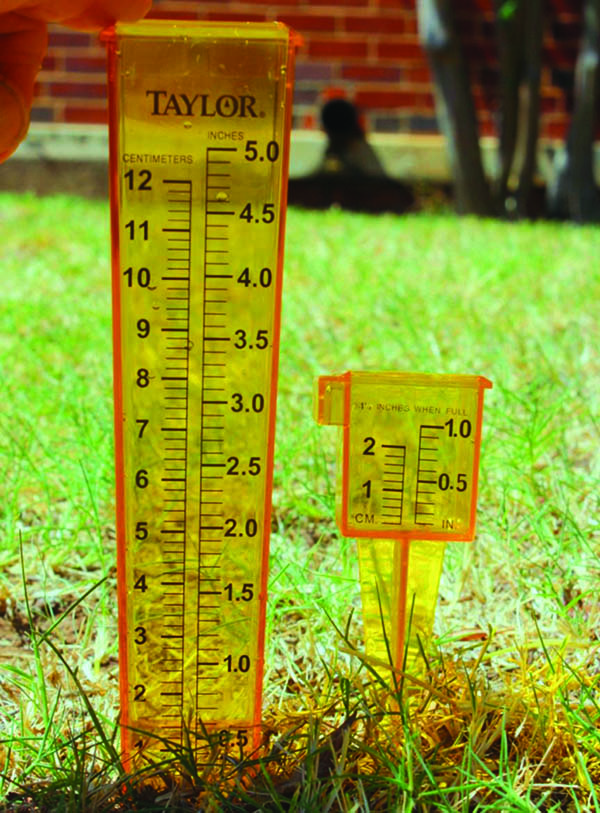
Figure 1. Examples of a short rain gauge (right) that can be used to conduct the simple irrigation audit procedure and a tall rain gauge (left) that should not be used to conduct the simple irrigation audit procedure.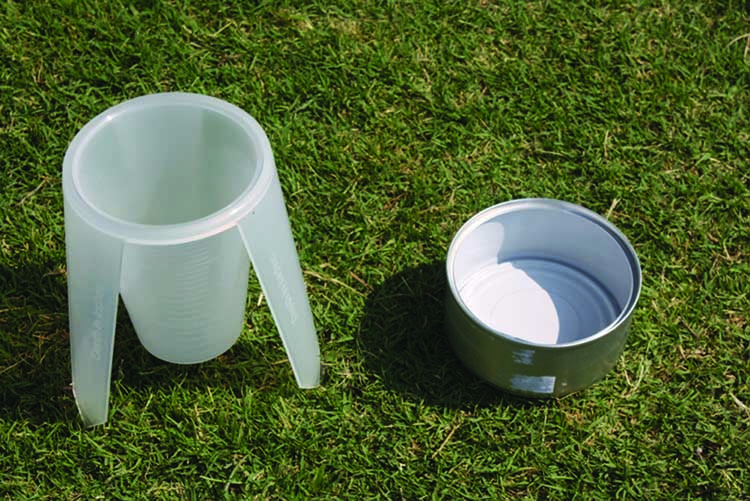
Figure 2. Examples of various catch cups that can be used to conduct the simple irrigation audit and examples of how to mark the side of the catch cups for more accurate irrigation output measurement.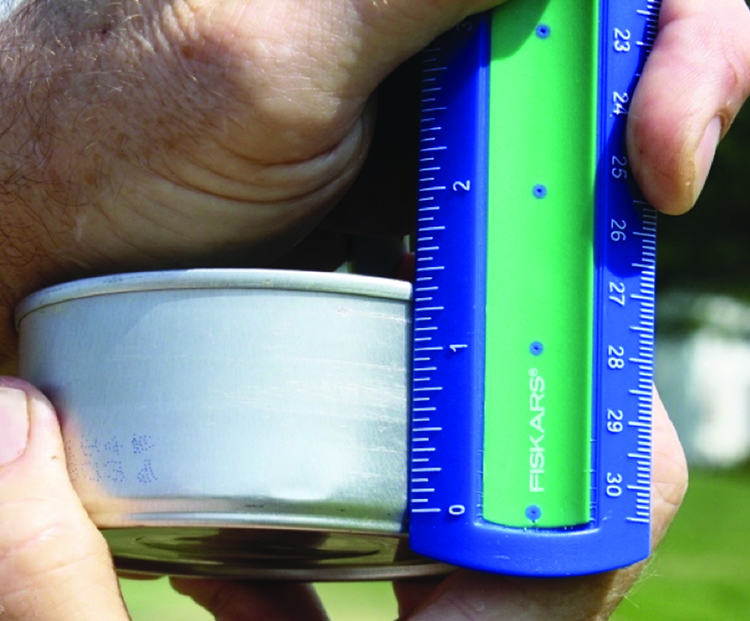
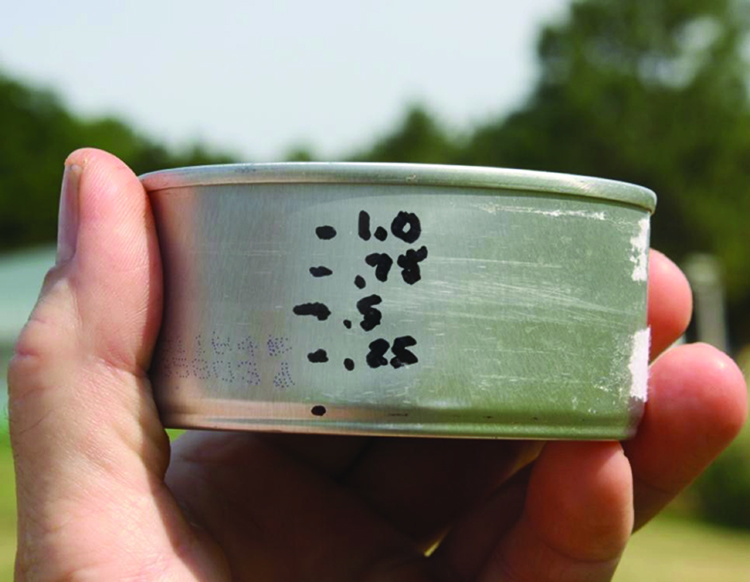
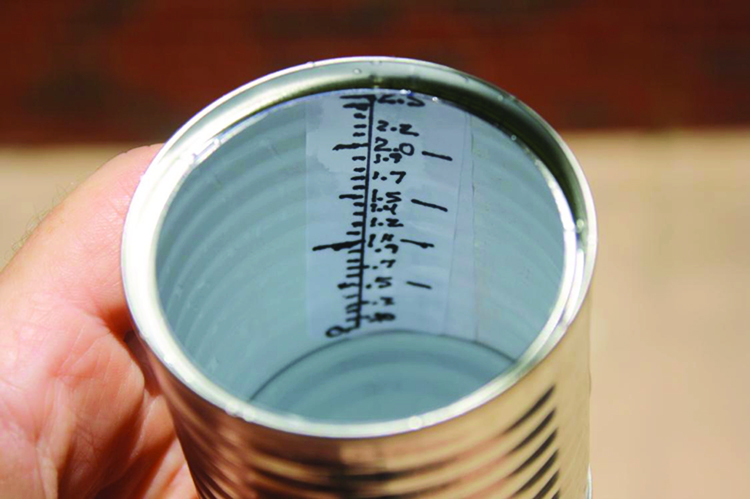

Figure 3. Examples of how to layout the irrigation catch cups in a grid pattern with each cup located about three steps apart from each other.
- Find an area of your lawn or landscape that is relatively flat and has no obstructions inside the perimeter of a square size area of approximately 16 feet x 16 feet (256 sq. ft.). Starting at the edge of the perimeter, set one catch cup down. Then measure approximately 8 feet, or about three steps, and place another catch cup. When you finish making your irrigation collection grid, it should appear as a square pattern (Figure 3). It is not necessary that these catch cups are measured out precisely.
- Set up a sprinkler along one side of the grid at the midpoint and check the sprinkler
“disperser” (usually a type of screw). Adjust where at least half of the sprinkler
output will cover your grid (Figure 4). You will be watering both sides of this square,
so arrange sprinkler placement where you will get good coverage for each side. If
you have an oscillating type sprinkler, just set it in the middle of the grid and
adjust for full coverage (you may have to adjust placement for windy conditions).
Hook up the water hose to one side and turn on to adjust spray pattern before timing.
Be sure to dump out any accumulated water in the catch cups when setting up sprinklers.
With an in-ground pop up irrigation system, try to find an area where you get good
coverage, possibly even between two lawn heads. Manually test the station(s) before
starting the time.

Figure 4. Proper placement of the catch cups in relation to your typical sprinkler location is imperative to obtain accurate irrigation output measurement.
2. Watering the Grid
Turn on your sprinkler system (or start one of the sprinklers) and let it run for 20 minutes. After the first side is complete move you sprinkler to the other side along the relative midpoint, and water the grid for an additional 20 minutes. If you are working with an oscillating sprinkler or automatic system, you will finish with the first timing. After 20 minutes, turn off irrigation and check your catch cups. If there is not a measurable amount in five out of the nine cups, you will need to water for one hour.
3. Irrigation Output and Uniformity Measurements
Gather your cups and with one of the measured cups, pour the water from the other eight catch cups into the ninth one. The cumulative amount will be the sum of all nine collection points. To obtain uniformity data, you also can measure each of the nine cups separately and record the exact amount collected in each cup (Figure 5). This data will give you an idea of how uniform your sprinklers or automatic system covers an area of your yard.

Figure 5. Note the relative uniformity of your irrigation output across the irrigation catch cup grid. If there is too much variation in the sprinkler pattern, you may need to hire a professional to adjust your irrigation system.
4. Measuring the Results
- To get the average output of your sprinkler(s) or automatic system, you need to do some basic math. Take the total of the catch cups’ measurement and divide by nine to find the average amount of output. If you watered for 20 minutes, you will need to multiply the average amount you just found by three—to get the output per hour.
- If you watered with sprinklers on each side for 20 minutes, you still multiply by three as this set up was for obtaining even coverage. Therefore: Total water collected in 20 minutes / 9 = average water collected in 20 minutes; and average water collected in 20 minutes x 3 = irrigation output in inches per hour.
5. Interpretation
- With this number you have a relative idea of what your typical irrigation output is when watering a lawn or landscape bed in inches per hour.
- What does this number tell you? It actually tells you a great deal more than just the “real world” output of your irrigation set up. You can compare this figure with how your sprinkler system is programmed.
- Measuring the irrigation amounts is a key component of knowing your lawn
- Many homeowners find that they have been overwatering their turfgrass. Remember, this figure is the output every time you water per hour. If you are watering your lawn for 30 minutes per session, and your output was only 0.2 inch/hour, that 30 minute session would only be delivering one-tenth inch of irrigation. On the other side of the spectrum, if your output number were larger, say .6 inch per hour, and your sprinkler system was set for 1 hour every day, this would apply 4.2 inches of irrigation per week, which is about four times more than what an established bermudagrass yard actually requires.
- Your output number is a good indicator of potentially causing needless water runoff. Municipal water costs will continue to rise over time. Therefore, excessively irrigating your lawn causes water to runoff into streets, storm drain systems or into lower areas of neighboring properties. This is a great example of the phrase, “pouring money down the drain.” Also, with excess irrigation runoff, there is a good chance that soil sediment, pesticides and fertilizers applied to the lawn and landscape are running into our creeks, streams, watersheds and reservoirs.
- Water conservation starts at home. Homeowners should know the importance of conserving water. Newer homes have efficient shower heads and toilets, along with water-conserving clothes washers. Some homeowners even have aerobic septic systems that take filtered septic water that irrigates part of the landscape. A typical home, using smart controllers on their sprinkler systems, plus each homeowner reducing the amount of irrigation time by using their irrigation audit output figure, can reduce a water bill by another 20 percent to 30 percent. For more information on home water conservation, see the EPA WaterSense website at: www.epa.gov/WaterSense.
General Lawn Irrigation Tips
In addition to the simple irrigation audit, the following tips adapted from the Irrigation Association (www.irrigation.org) also can help you to conserve water when watering your lawn.
- Adapt your watering schedule to the weather and the season. Familiarize yourself with the settings on your irrigation controller. Adjust the watering schedule regularly to conform to current weather conditions. There are many times during the year when natural rainfall will provide adequate water to the lawn and landscape.
- Turn off the faucet. Turfgrasses, such as bermudagrass, have good drought resistant and are resilient. Although the grass may go dormant and turn brown during hot and dry periods, the crown or base of the plant will stay alive. Once the grass receives natural rainfall in the late summer or fall, it will actively grow and turn green again. A few key irrigation events may be needed, but watering deeply once a week to once every two weeks can be enough to enable the grass to green up once rainfall returns.
- Schedule each individual zone in your irrigation system. “Scheduling” accounts for the type of sprinkler, sun or shade exposure, and the soil type for the specific area. The same watering schedule should almost never apply to all zones in the system.
- Inspect your system monthly. Check for leaks, broken or clogged heads, and other problems. You also could ask an irrigation professional to regularly check your system. Clean micro-irrigation filters as needed.
- Adjust sprinkler heads. Correct obstructions that prevent sprinklers from distributing water evenly. Keep water off pavement and structures.
- Consider a professional irrigation system audit. If you find that your irrigation system may need adjustment based on the simple irrigation audit, you can hire a certified irrigation auditor to conduct a professional irrigation audit. The professional irrigation auditor can give you specific tips and plans to improve the efficiency of your irrigation system. The Irrigation Association maintains an online list of Certified Landscape Irrigation Auditors. You can visit their website at: www.irrigation.org.
- Consider “smart” technology. Climate- or soil moisture sensor-based controllers evaluate weather or soil moisture conditions, then calculates and automatically adjusts the irrigation schedule to meet the specific needs of your landscape.
- Install a rain shutoff-switch—inexpensive and effective. Required by law in many states, these money-saving sensors turn off your system in rainy weather and help to compensate for natural rainfall. The device can be retrofitted to almost any system.
- Consider low volume drip irrigation for plant beds. Install micro-irrigation for gardens, trees and shrubs. Micro-irrigation includes drip (also known as trickle), micro-spray jets, micro-sprinklers or bubbler irrigation to irrigate slowly and minimize evaporation, runoff and overspray.
- Water at the optimum time. Water when the sun is low or down, winds are calm and temperatures are cool, between the evening and early morning, to reduce evaporation. You can lose as much as 50 percent of water to evaporation by watering mid-day.
- Water deeply and infrequently. Saturate root zones and let the soil dry. Watering too much and too frequently results in shallow roots, and may increase weed growth and disease incidence.
Summary
It is important to know the general output and uniformity of your lawn irrigation system for proper lawn watering. Homeowners often wonder how long they should irrigate their lawns, but the volume of applied irrigation water cannot be directly measured in units of time. Now that you have conducted this simple irrigation audit, you have a good estimate of how much water is applied to your lawn over time in terms of inches per hour. This simple procedure may save you money and can help to conserve Oklahoma water resources. The following information is provided for you concerning how to obtain materials to conduct the simple irrigation audit and to find a short video demonstrating this procedure:
- Short rain gauges can be found at many local and online retailers. Look for a rain gauge similar to the one shown in Figure 1.
- A short video clip from the Oklahoma Gardening television program demonstrating this process can be found by visiting http://turf.okstate.edu and clicking on the “Homeowners” link.
Justin Q. Moss
Turfgrass Research and Extension
John E. Haase
Extension Horticulturist
Dennis L. Martin
Extension Turfgrass Specialist
Jason R. Vogel
Extension Stormwater Specialist
Tracy A. Boyer
Agricultural Economist
